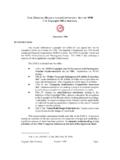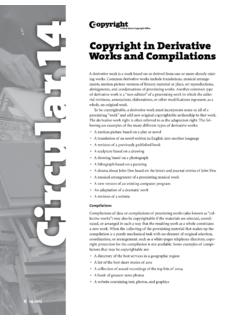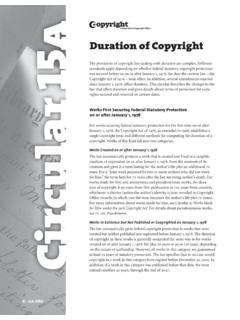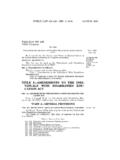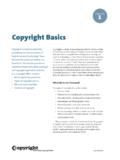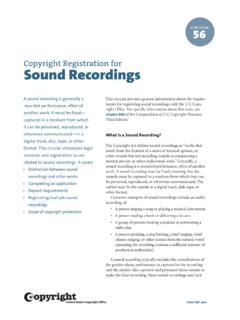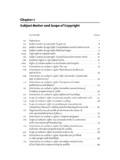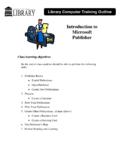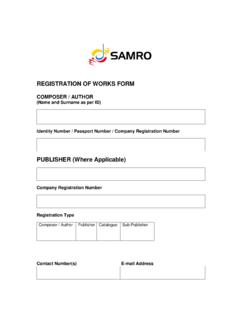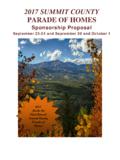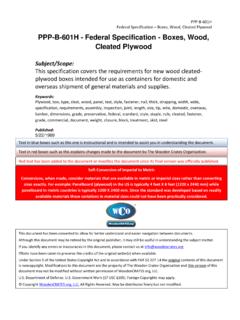Transcription of Reproduction of Copyrighted Works by Educators …
1 WCircular 212 of Copyrighted Works by Educators and LibrariansMany Educators and librarians ask about the fair use and photocopying provi-sions of the copyright law. The Copyright Office cannot give legal advice or offer opinions on what is permitted or prohibited. However, we have published in this circular basic information on some of the most important legislative provisions and other documents dealing with Reproduction by librarians and available is the 1983 Report of the Register of Copyrights on Library Reproduction of Copyrighted Works (17 108).
2 The Report, seven appen-dixes, and other related materials can be purchased from the National Technical Information Service (NTIS), Department of Commerce, 5301 Shawnee Rd., Alexandria, VA 22312. Go to the NTIS website at For further infor-mation, call NTIS at 1-800-553-6847 or (703) 1988 five-year Report of the Register of Copyrights on Library Repro-duction of Copyrighted Works is also available from Introductory NoteThe Subjects Covered in This BookletThe documentary materials collected in this circular deal with Reproduction of Copyrighted Works by Educators , librarians, and archivists for a variety of uses, including.
3 Reproduction for teaching in educational institutions at all levels and Reproduction by libraries and archives for purposes of study, research, interlibrary exchanges, and archival documents reprinted here are limited to materials dealing with reproduc-tion. Under the copyright law, Reproduction can take either of two forms: The making of copies: by photocopying, making microform reproductions, videotaping, or any other method of duplicating visually-perceptible material and The making of phonorecords: by duplicating sound recordings, taping off the air, or any other method of recapturing copyright law also contains various provisions dealing with importations, performances, and displays of Copyrighted Works for educational and other noncommercial purposes, but they are outside the scope of this circular.
4 You can view and download the statute from the Copyright Office website at Reproduction of Copyrighted Works To purchase a copy, go to and search for Circular 92. For information about specific provisions, write to: Library of Congress Copyright Office-COPUBS 101 Independence Avenue SE Washington, DC 20559-6304A Note on the Documents ReprintedThe documentary materials in this booklet are reprints or excerpts from six sources:1 The Copyright Act of October 19, 1976. This is the copy-right law of the United States, effective January 1, 1978 (title 17 of the United States Code, Public Law 94-553, 90 Stat.)
5 2541).2 The Senate Report. This is the 1975 report of the Senate Judiciary Committee on S. 22, the Senate version of the bill that became the Copyright Act of 1976 (S. Rep. No. 94-473, 94th Cong., 1st Sess., November 20 (legislative day November 18, 1975)).3 The House Report. This is the 1976 report of the House of Representatives Judiciary Committee on the House amendments to the bill that became the Copyright Act of 1976 ( Rep. No. 94-1476, 94th Cong., 2d Sess., Sep-tember 3, 1976).4 The Conference Report. This is the 1976 report of the committee of conference on the disagreeing votes of the two Houses on the amendments of the House to the bill (S.
6 22) for the general revision of the Copyright Law ( Rep. No. 94-1733, 94th Cong., 2d Sess., September 29, 1976).5 The Congressional Debates. This booklet contains excerpts from the Congressional Record of September 22, 1976, reflecting statements on the floor of Congress at the time the bill was passed by the House of Representatives (122 Cong. Rec. H 10874-76, daily edition, September 22, 1976).6 Copyright Office Regulations. These are regulations issued by the Copyright Office under section 108 deal-ing with warnings of copyright for use by libraries and archives (37 Code of Federal Regulations ).
7 Items 2 and 3 on this list the 1975 Senate Report and the 1976 House Report present special problems. On many points the language of these two reports is identical or closely similar. However, the two reports were written at different times, by committees of different Houses of Congress, on somewhat different bills. As a result, the discussions on some provisions of the bills vary widely, and on certain points they disagreements between the Senate and House ver-sions of the bill itself were resolved when the Act of 1976 was finally passed. However, many of the disagreements as to matters of interpretation between statements in the 1975 Senate Report and in the 1976 House Report were left partly or wholly unresolved.
8 It is therefore difficult in compiling a booklet such as this to decide in some cases what to include and what to leave House Report was written later than the Senate Report, and in many cases it adopted the language of the Senate Report, updating it and conforming it to the version of the bill that was finally enacted into law. Thus, where the differences between the two Reports are relatively minor, or where the discussion in the House Report appears to have superseded the discussion of the same point in the Senate Report, we have used the House Report as the source of our documentation.
9 In other cases we have included excerpts from both discussions in an effort to present the legislative history as fully and fairly as possible. Anyone making a thor-ough study of the Act of 1976 as it affects librarians and edu-cators should not rely exclusively on the excerpts reprinted here but should go back to the primary documentary Exclusive Rights in Copyrighted Works1. Text of Section 106note: The following is a reprint of the entire text of section 106 of title 17, United States Code, as amended in 1995 and 2002. 106 Exclusive rights in Copyrighted worksSubject to sections 107 through 122, the owner of copyright under this title has the exclusive rights to do and to authorize any of the following: (1) to reproduce the Copyrighted work in copies or phonorecords;(2) to prepare derivative Works based upon the Copyrighted work ;(3) to distribute copies or phonorecords of the Copyrighted work to the public by sale or other transfer of ownership, or by rental, lease, or lending.
10 (4) in the case of literary, musical, dramatic, and choreo-graphic Works , pantomimes, and motion pictures andReproduction of Copyrighted Works 3other audio visual Works , to perform the Copyrighted work publicly;(5) in the case of literary, musical, dramatic, and choreo-graphic Works , pantomimes, and pictorial, graphic, or sculptural Works , including the individual images of a motion picture or other audiovisual work , to display the Copyrighted work publicly; and(6) in the case of sound recordings, to perform the copy-righted work publicly by means of a digital audio Excerpts from House Report on Section 106note: The following excerpts are reprinted from the House Report on the new copyright law ( Rep.)
